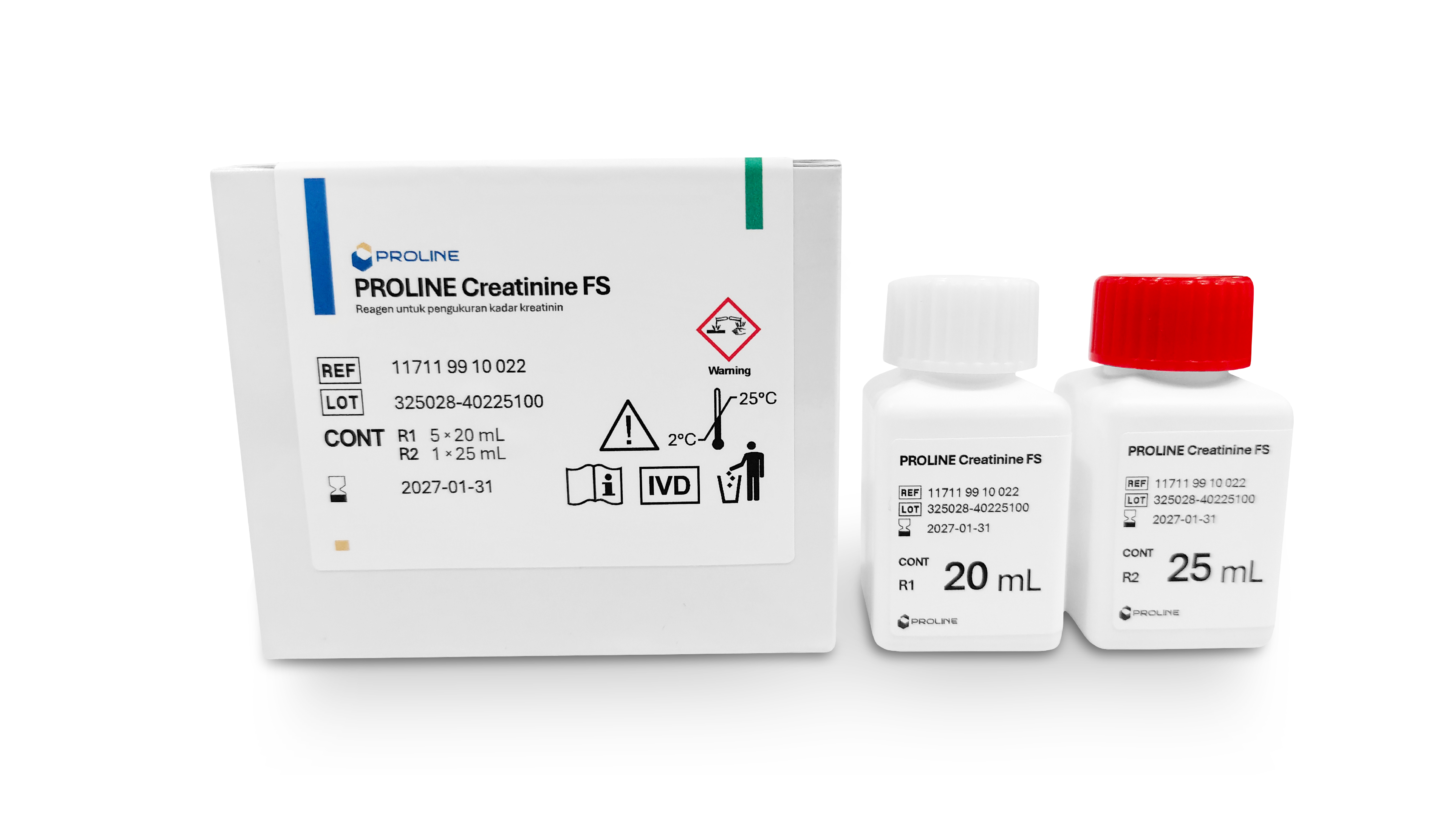PROLINE Creatinine FS

| Catalogue Number | R1 Reagent Volume | R2 Reagent Volume |
| 11711 99 10 920 | 4 x 34 mL | 4 x 10 mL |
| 11711 99 10 921 | 4 x 21 mL | 4 x 6 mL |
| 11711 99 10 191 | 4 x 36 mL | 4 x 9 mL |
| 11711 99 10 181 | 4 x 36 mL | 4 x 9 mL |
| 11711 99 10 022 | 5 x 20 mL | 1 x 25 mL |
| 11711 99 10 025 | 3 x 80 mL | 1 x 60 mL |
| 11711 99 10 029 | 3 x 200 mL | 1 x 150 mL |
| 11711 99 10 965 | 6 x 25 mL | 6 x 6 mL |
| 11711 99 10 914 | 6 x 60 mL | 6 x 15 mL |
| 11711 99 10 951 | 6 x 36 mL | 6 x 9 mL |
| 11711 99 10 591 | 4 x 60 mL | 4 x 15 mL |
| 11711 99 10 027 | 2 x 100 mL | 2 x 25 mL |
A diagnostic reagent for the quantitative determination of creatinine in serum, plasma, or urine in vitro using a photometric system.
Creatinine is a breakdown product derived from dietary meat and creatine phosphate found in skeletal muscle. The production of creatinine in the body depends on muscle mass. Creatinine is not eliminated through extra-renal pathways, and under steady-state conditions, the amount excreted in urine equals the amount produced. The creatinine analyte is used to estimate the glomerular filtration rate (GFR), which is an indicator of kidney function.
An increase in plasma creatinine levels generally indicates a decrease in creatinine excretion, which may result from impaired kidney function. Creatinine clearance is used as an indicator to estimate the glomerular filtration rate (GFR), a key parameter in detecting kidney disease and monitoring kidney function over time. For this purpose, creatinine levels are measured simultaneously in serum and urine collected over a specified period (usually 24 hours) to calculate the creatinine clearance rate.
A decline in the kidneys' ability to filter creatinine leads to its accumulation in the blood, indicating impaired kidney function or chronic kidney disease. Therefore, creatinine plays a vital role as a clinical biomarker for the early diagnosis and monitoring of the progression of kidney disorders.
Using the kinetic test method without deproteinization based on the Jaffé method.
- Ready-to-use liquid reagent (open-system) without reconstitution
- Excellent linearity and stability performance
- Available in MPK (Multi-Purpose Kit) and dedicated kit
- Compatible with >65 brands of manual and automated clinical chemistry analyzers
| Sample type | Serum, Plasma or Urine |
| Measurement range | Serum: 0,1 mg/dL - 18,5 mg/dL Urine: 11 mg/dL - 450 mg/dL |
| Analysis wavelength | Hg 492 nm, (490 – 510 nm) |
| Analysis mode | Kinetic |
| Reagent volume used (analyzer manual) | R1: 1000 µL ; R2: 250 µL |
| Sample volume used (analyzer manual) | 50 µL |
| Storage temperature | 2 – 25 °C |
| Open vial stability | 18 months |
| Expiration date | 24 months |
| Control for Creatinine Reagent | Calibrator for Creatinnine Reagent |
| TruLab N | TruCal U |
| TruLab P | Creatinine Standard FS |
| Reference Range: | ||
| Serum/Plasma, uncompensated Jaffé method | ||
| mg/dL | μmol/L | |
| Adult | ||
| Woman | 0,6 - 1,1 | 53 - 97 |
| Man | 0,7 - 1,3 | 62 - 115 |
| Children | ||
| Neonates | 0,5 - 1,2 | 44 - 106 |
| Infant | 0,4 - 0,7 | 35 - 62 |
| Child | 0,5 - 1,2 | 44 - 106 |
| Serum/Plasma, compensated Jaffé method | ||
| mg/dL | μmol/L | |
| Adult | ||
| Woman | 0,5 - 0,9 | 44 - 80 |
| Man | 0,7 - 1,2 | 62 - 106 |
| Children | ||
| Neonates | 0,24 - 1,04 | 21 - 92 |
| Infant | 0,17 - 0,42 | 15 - 37 |
| Child | 0,24 - 0,87 | 21 - 77 |
| 24-hour Urine | ||
| Woman | 11 - 20 mg/kg/24 Hours | 97 - 177 µmol/kg/24 Hours |
| Man | 14 - 26 mg/kg/24 Hours | 124 - 230 µmol/kg/24 Hours |
| Albumin/Creatinine Ratio (first morning urine) | < 30 mg/g creatinine | |
| Creatinine Clearance | ||
| Female | 95 - 160 mL/min/1,73 m2 | |
| Male | 98 - 156 mL/min/1,73 m2 | |
- Creatinine reagent
- Doos
- Kit insert
- Reagents bottle
- Shahbaz H, Rout P, Gupta M. Creatinine Clearance. [Updated 2024 Jul 27]. In: StatPearls [Internet]. Treasure Island (FL): StatPearls Publishing; 2025 Jan-. Available from: https://www.ncbi.nlm.nih.gov/books/NBK544228/
- Levey AS, Bosch JP, Lewis JB, Greene T, Rogers N, Roth D. A more accurate method to estimate glomerular filtration rate from serum creatinine: a new prediction equation. Modification of Diet in Renal Disease Study Group. Ann Intern Med. 1999 Mar 16;130(6):461-70. doi: 10.7326/0003-4819-130-6-199903160-00002. PMID: 10075613.
- R D Perrone, N E Madias, A S Levey, Serum Creatinine as an Index of Renal Function: New Insights into Old Concepts, Clinical Chemistry, Volume 38, Issue 10, 1 October 1992, Pages 1933–1953, https://doi.org/10.1093/clinchem/38.10.1933
- Brochure : INA
- Kidney disease
Contact our team to find out more product information and ordering
- Telp : +62 21 8984 2722
- WhatsApp : +62 815 1359 2626
- Email : marketing@proline.co.id
Contact our Technical support team for further assistance with product specifications, services and other technical documents.
- Telp : +62-21-8984-2722
- WhatsApp : +62-817-9324-884
- Email : technical.support@prodis.co.id
